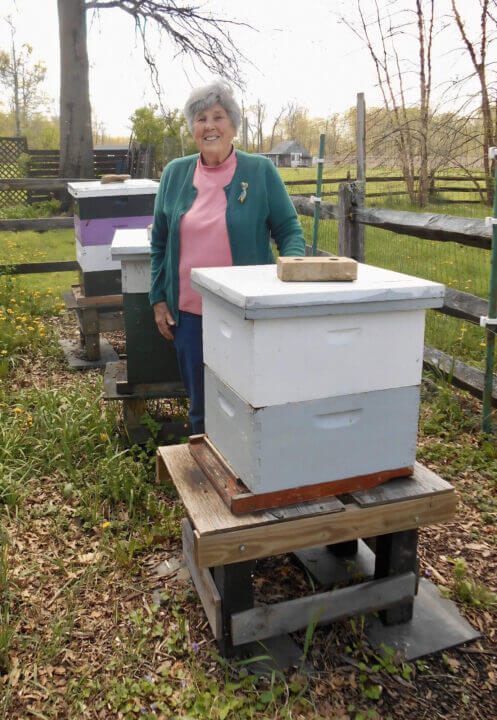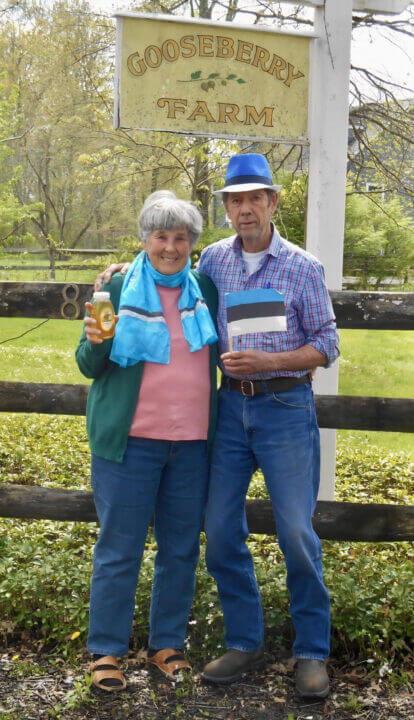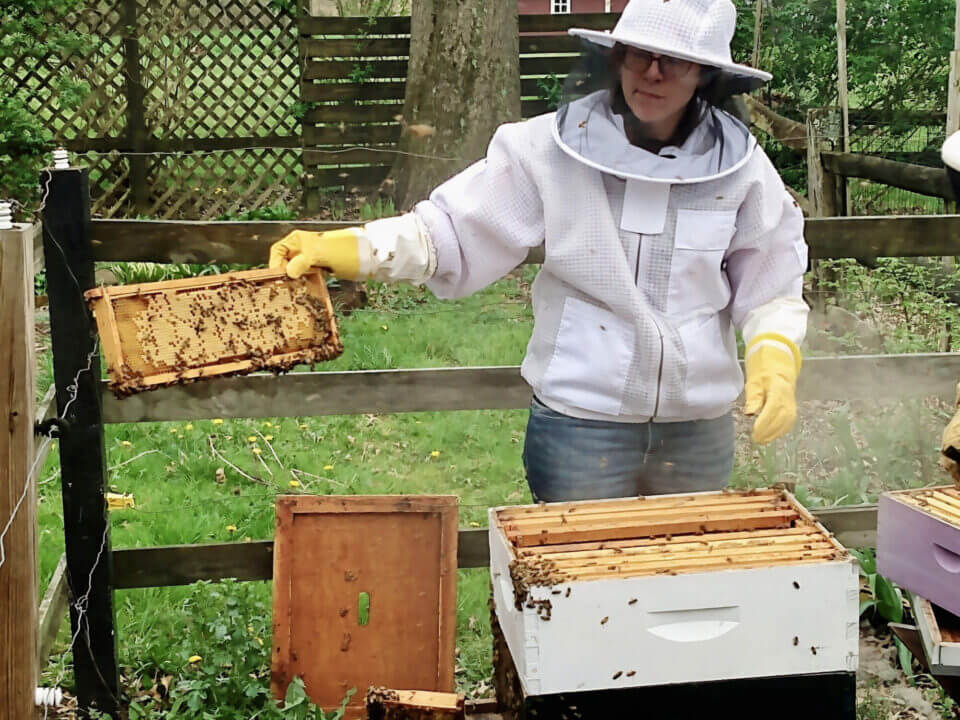World Bee Day is observed on May 20th each year to highlight the essential role bees and other pollinators play in keeping people and the planet healthy.
I was invited by Mare and Richard Olsen to spend a breezy, beautiful Sunday afternoon at their “Gooseberry Farm” – or “Tikerberi talu” in Estonian – where they recounted their beekeeping journey.
Mare, originally from Valga, Estonia, and her husband Richard have been keeping bees for fifteen years. As Richard explains, “When I retired in 2008 Mare declared, ‘You have to do something.'” They had heard about beekeeping, took a course, collected equipment, and began their bee odyssey. Richard credits bee-whisperer Rich Lepik as their mentor, who taught them how to remove honey from the hives. “Other people use harsher methods, but Rich showed us how it can be done gently, without bothering the bees,” recounts Richard.
“We started with two hives, and have had as many as five, although we have three now,” states Mare.
Some effort and time are necessary with this undertaking. As Mare details, “To keep the bees healthy, the hives need to be regularly treated for varroa mites, parasites which can devastate an entire hive if left unchecked.”
The hive’s health depends on its population density. “Collecting nectar and pollen when everything is blossoming, and the queen busy laying eggs, the pressure in the hives grows. If a hive can’t accommodate the increase in bees, then some prepare for a big, important event: swarming. Some of the bees break off from the colony, following the scout bees searching for a new home.”
Richard is on the Morris County list for swarm removal. If bees have been unable to find a suitable spot, the swarm might stop in the upper branches of trees, in bushes – really anywhere. That’s when Richard and Mare rush to the rescue. If they are able to collect the swarm in a container or box, they then have to find a new home for the swarm. Mare narrates, “Maybe a beekeeper has lost a hive for whatever reason, or a new beekeeper is in search of bees. If the queen bee is in the middle of the swarm, then they don’t have to buy a new one. [Queen bees can be ordered from catalogues!] Once a new hive has been located, we situate the box of bees in front of it and it’s amazing to see the troop march in a calm, organized, disciplined column, stoically, with purpose and intention into their new home.”



But sometimes fate has something else in store.
As Mare recalls, “On one swarm removal call we were told that the swarm had come from a hole in an oak tree – and it was up high in another tree. We weren’t able to collect it, but the whole swarm flew over the rooftops – it was like an airplane taking off – the sky was all black and it was pretty frightening. They’re not aggressive, but on a mission. Hopefully the scouts had found a suitable location, they had their queen with them, and everything was well in their world.”
If swarms are left alone, they have been known to get under the eaves or shingles of houses. Bees are comfortable in buildings and quiet when in the hive, so homeowners can remain unaware that they are housing a huge bee colony!
The joys of beekeeping are many, according to Mare. “When the weather gets warmer, the bees clean their quarters and take cleansing flights, ridding themselves of the hive’s winter mustiness, as a first sauna would refreshen us. In the spring, when picking weeds, I see them land with little pollen pockets on their back legs, sometimes crash landing, heavily laden with pollen, and enter the hive. They unload, look around and fly off again – such beguiling little beings!”
The Olsens enjoy talking with other beekeepers – like-minded conservationists, who appreciate nature.
A great reward for their efforts is collecting honey in late June/early July and sometimes in the fall if flowers continue blooming late that year. From their three hives, a little under 200 pounds of honey is collected. When the frames within the hives are full of brood (eggs, larvae, and pupae) and honey, they become quite heavy to handle. Mare has noticed that many beekeepers in her area are women, who prefer medium-sized, lighter boxes. Needless to say, Mare and Richard never use sugar.
“I recommend beekeeping to everyone!” exclaims Mare. “Richard has mentored at least two people – one for whom he caught a swarm in her azalea bush and another who lives in an urban environment but had longed for bees.”
Life is full of fascinating coincidences – or are they? Mare and Richard’s son went to Estonia, where he met and married his wife. For some years, they lived on a farm in Minnesota but returned to Estonia with their children. They now reside east of Valga in Lülle-mäe, in the Karula National Park – where they keep seven hives. As Richard details, “I mentored our son with his hives, and he even has a secret recipe for making mead with their honey, raisins, and other ingredients. I must admit, it’s quite good!”
Mare contemplates the fact that her son is raising their grandchildren very close to where she herself lived before the war.
“I see something mystical in these episodes. It’s a circle that ends in opposite directions, a mystery of life that keeps on going – like a Mobius.”
After hearing their tale, it seems we should all raise bees, collect honey, quaff homemade mead, and ponder the wonders of fate – proosit!
Text and photos by
Virve Jõks Lane
















